Hyundai Grand Santa Fe 2014 Owner's Manual
Manufacturer: HYUNDAI, Model Year: 2014, Model line: Grand Santa Fe, Model: Hyundai Grand Santa Fe 2014Pages: 718, PDF Size: 13.5 MB
Page 681 of 718
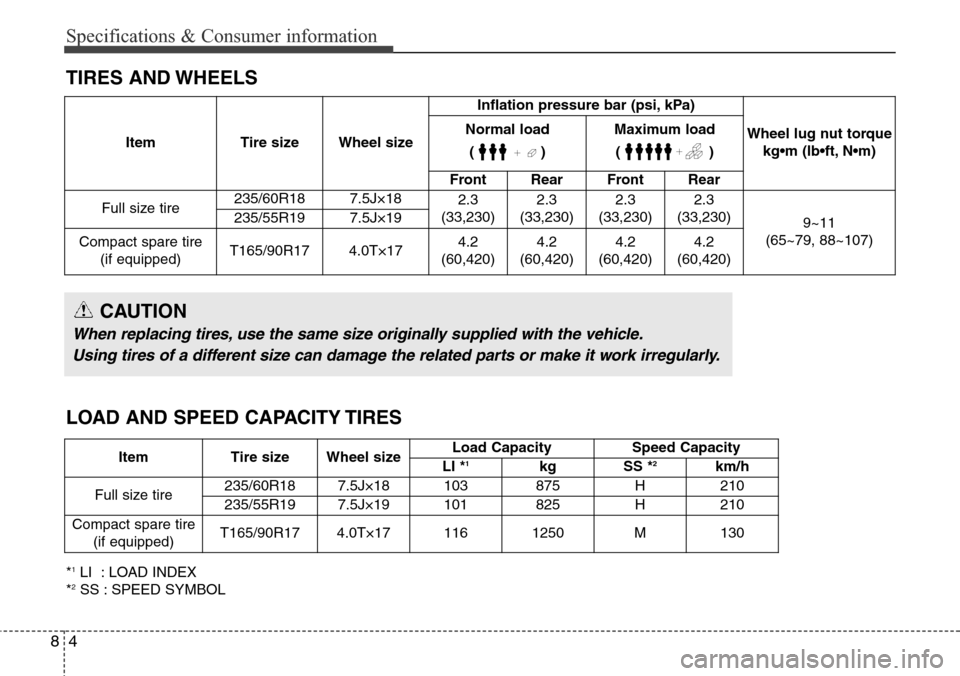
Specifications & Consumer information
4 8
TIRES AND WHEELS
Item Tire size Wheel sizeInflation pressure bar (psi, kPa)
Wheel lug nut torque
kgŌĆóm (lbŌĆóft, NŌĆóm) Normal load
()Maximum load
()
Front Rear Front Rear
Full size tire235/60R18 7.5J├Ś18
2.3
(33,230)2.3
(33,230)2.3
(33,230)2.3
(33,230)
9~11
(65~79, 88~107) 235/55R19 7.5J├Ś19
Compact spare tire
(if equipped)T165/90R17 4.0T├Ś174.2
(60,420)4.2
(60,420)4.2
(60,420)4.2
(60,420)
CAUTION
When replacing tires, use the same size originally supplied with the vehicle.
Using tires of a different size can damage the related parts or make it work irregularly.
*1LI : LOAD INDEX
*2SS : SPEED SYMBOLItem Tire size Wheel sizeLoad Capacity Speed Capacity
LI *
1kg SS *2km/h
Full size tire235/60R18 7.5J├Ś18 103 875 H 210
235/55R19 7.5J├Ś19 101 825 H 210
Compact spare tire
(if equipped)T165/90R174.0T├Ś171161250M130
LOAD AND SPEED CAPACITY TIRES
Page 682 of 718
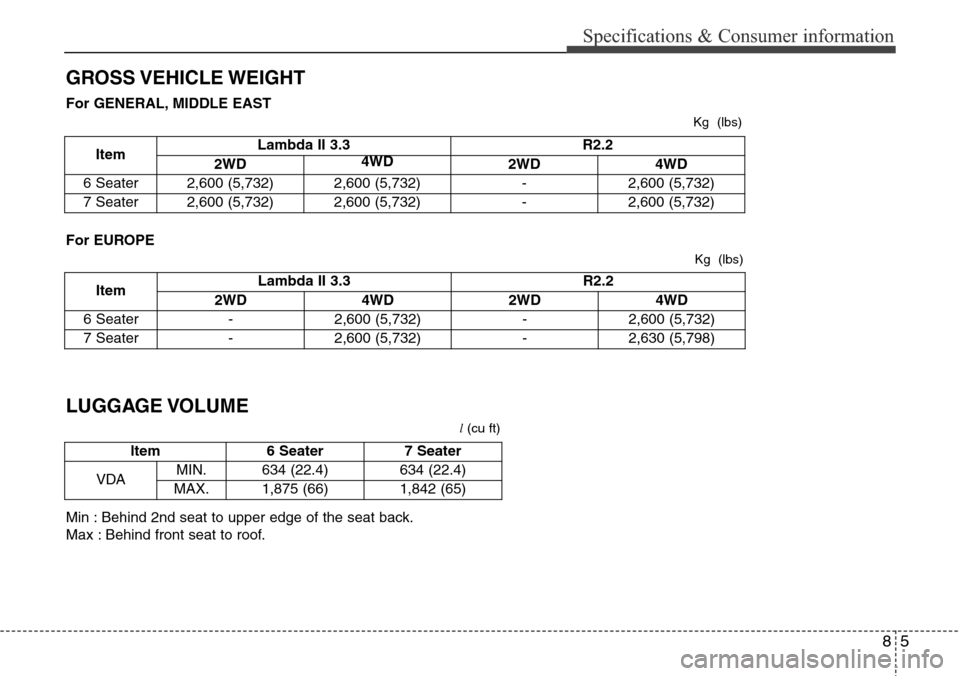
85
Specifications & Consumer information
GROSS VEHICLE WEIGHT
ItemLambda II 3.3 R2.2
2WD 4WD 2WD 4WD
6 Seater - 2,600 (5,732) - 2,600 (5,732)
7 Seater - 2,600 (5,732) - 2,630 (5,798)
ItemLambda II 3.3 R2.2
2WD4WD
2WD 4WD
6 Seater 2,600 (5,732)
2,600 (5,732) - 2,600 (5,732)
7 Seater 2,600 (5,732)
2,600 (5,732) - 2,600 (5,732)
For GENERAL, MIDDLE EAST
For EUROPE
ltem 6 Seater 7 Seater
VDAMIN. 634 (22.4) 634 (22.4)
MAX. 1,875 (66) 1,842 (65)
Min : Behind 2nd seat to upper edge of the seat back.
Max : Behind front seat to roof.
LUGGAGE VOLUME
Kg (lbs)
Kg (lbs)
l(cu ft)
Page 683 of 718
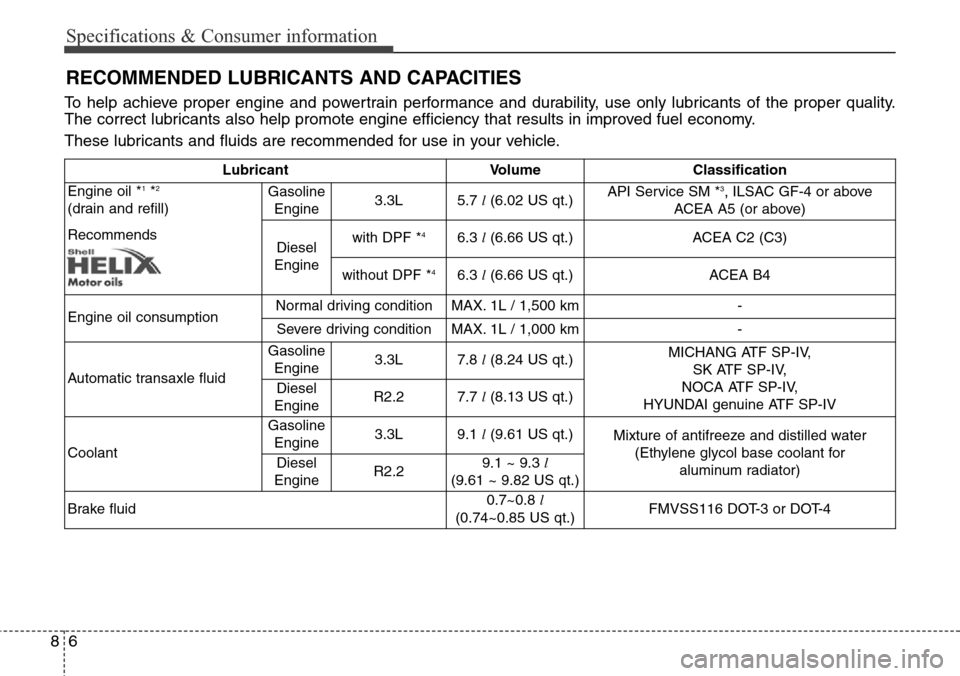
Specifications & Consumer information
6 8
RECOMMENDED LUBRICANTS AND CAPACITIES
To help achieve proper engine and powertrain performance and durability, use only lubricants of the proper quality.
The correct lubricants also help promote engine efficiency that results in improved fuel economy.
These lubricants and fluids are recommended for use in your vehicle.
Lubricant Volume Classification
Engine oil *
1*2
(drain and refill)
RecommendsGasoline
Engine3.3L5.7 l(6.02 US qt.)API Service SM *
3, ILSAC GF-4 or above
ACEA A5 (or above)
Diesel
Enginewith DPF *
46.3 l(6.66 US qt.)
ACEA C2 (C3)
without DPF *
46.3 l(6.66 US qt.)
ACEA B4
Engine oil consumption Normal driving condition MAX. 1L / 1,500 km -
Severe driving condition MAX. 1L / 1,000 km -
Automatic transaxle fluid Gasoline
Engine3.3L7.8 l(8.24 US qt.)MICHANG ATF SP-IV,
SK ATF SP-IV,
NOCA ATF SP-IV,
HYUNDAI genuine ATF SP-IV Diesel
EngineR2.27.7 l(8.13 US qt.)
Coolant
Gasoline
Engine3.3L9.1 l(9.61 US qt.)Mixture of antifreeze and distilled water
(Ethylene glycol base coolant for
aluminum radiator)
Diesel
EngineR2.29.1 ~ 9.3 l
(9.61 ~ 9.82 US qt.)
Brake fluid0.7~0.8 l
(0.74~0.85 US qt.)FMVSS116 DOT-3 or DOT-4
Page 684 of 718
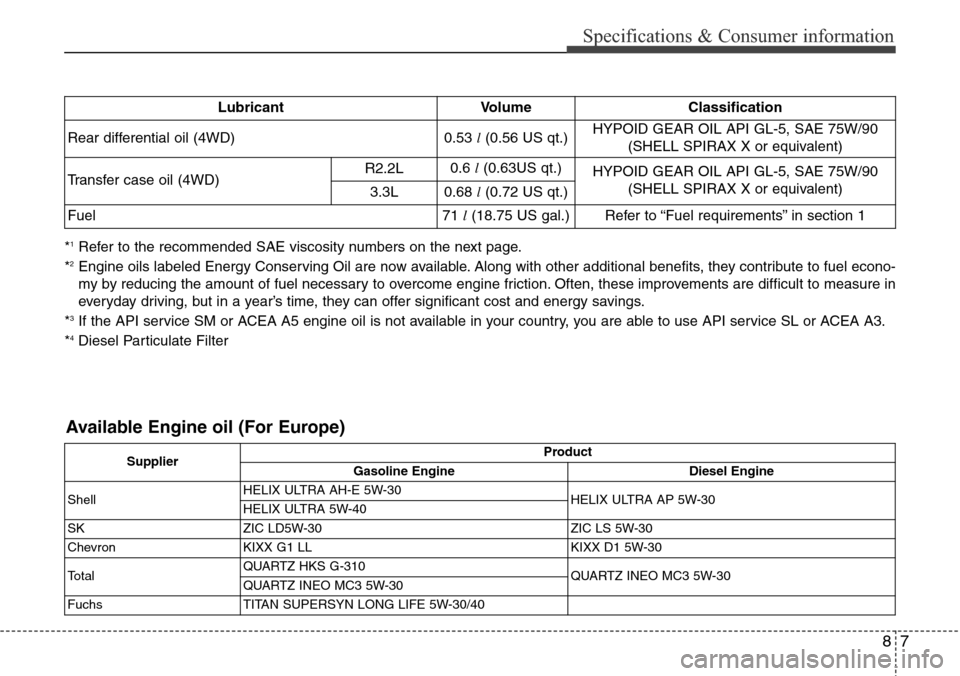
87
Specifications & Consumer information
*1Refer to the recommended SAE viscosity numbers on the next page.
*2Engine oils labeled Energy Conserving Oil are now available. Along with other additional benefits, they contribute to fuel econo-
my by reducing the amount of fuel necessary to overcome engine friction. Often, these improvements are difficult to measure in
everyday driving, but in a yearŌĆÖs time, they can offer significant cost and energy savings.
*
3If the API service SM or ACEA A5 engine oil is not available in your country, you are able to use API service SL or ACEA A3.
*4Diesel Particulate FilterLubricant Volume Classification
Rear differential oil (4WD)0.53 l(0.56 US qt.)HYPOID GEAR OIL API GL-5, SAE 75W/90
(SHELL SPIRAX X or equivalent)
Transfer case oil (4WD) R2.2L0.6 l(0.63US qt.)
HYPOID GEAR OIL API GL-5, SAE 75W/90
(SHELL SPIRAX X or equivalent)
3.3L0.68 l(0.72 US qt.)
Fuel71 l(18.75 US gal.)
Refer to ŌĆ£Fuel requirementsŌĆØ in section 1
Available Engine oil (For Europe)
SupplierProduct
Gasoline Engine Diesel Engine
ShellHELIX ULTRA AH-E 5W-30
HELIX ULTRA AP 5W-30
HELIX ULTRA 5W-40
SK ZIC LD5W-30 ZIC LS 5W-30
Chevron KIXX G1 LL KIXX D1 5W-30
TotalQUARTZ HKS G-310
QUARTZ INEO MC3 5W-30
QUARTZ INEO MC3 5W-30
Fuchs TITAN SUPERSYN LONG LIFE 5W-30/40
Page 685 of 718
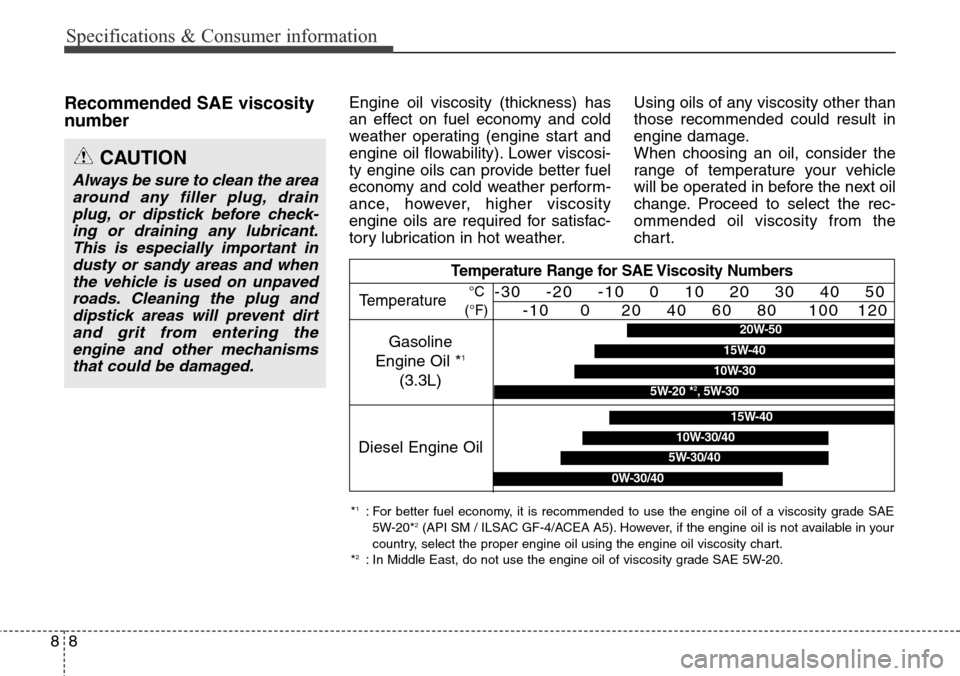
Specifications & Consumer information
8 8
Recommended SAE viscosity
number Engine oil viscosity (thickness) has
an effect on fuel economy and cold
weather operating (engine start and
engine oil flowability). Lower viscosi-
ty engine oils can provide better fuel
economy and cold weather perform-
ance, however, higher viscosity
engine oils are required for satisfac-
tory lubrication in hot weather.Using oils of any viscosity other than
those recommended could result in
engine damage.
When choosing an oil, consider the
range of temperature your vehicle
will be operated in before the next oil
change. Proceed to select the rec-
ommended oil viscosity from the
chart.
CAUTION
Always be sure to clean the area
around any filler plug, drain
plug, or dipstick before check-
ing or draining any lubricant.
This is especially important in
dusty or sandy areas and when
the vehicle is used on unpaved
roads. Cleaning the plug and
dipstick areas will prevent dirt
and grit from entering the
engine and other mechanisms
that could be damaged.
*1: For better fuel economy, it is recommended to use the engine oil of a viscosity grade SAE
5W-20*2(API SM / ILSAC GF-4/ACEA A5). However, if the engine oil is not available in your
country, select the proper engine oil using the engine oil viscosity chart.
*
2: In Middle East, do not use the engine oil of viscosity grade SAE 5W-20.
Temperature Range for SAE Viscosity Numbers
Temperature
Gasoline
Engine Oil *1
(3.3L)
┬░C
(┬░F)-30 -20 -10 0 10 20 30 40 50
-10 0 20 40 60 80 100 120
Diesel Engine Oil5W-30/40
15W-40
10W-30/40
0W-30/40
20W-50
10W-30
15W-40
5W-20 *2, 5W-30
Page 686 of 718
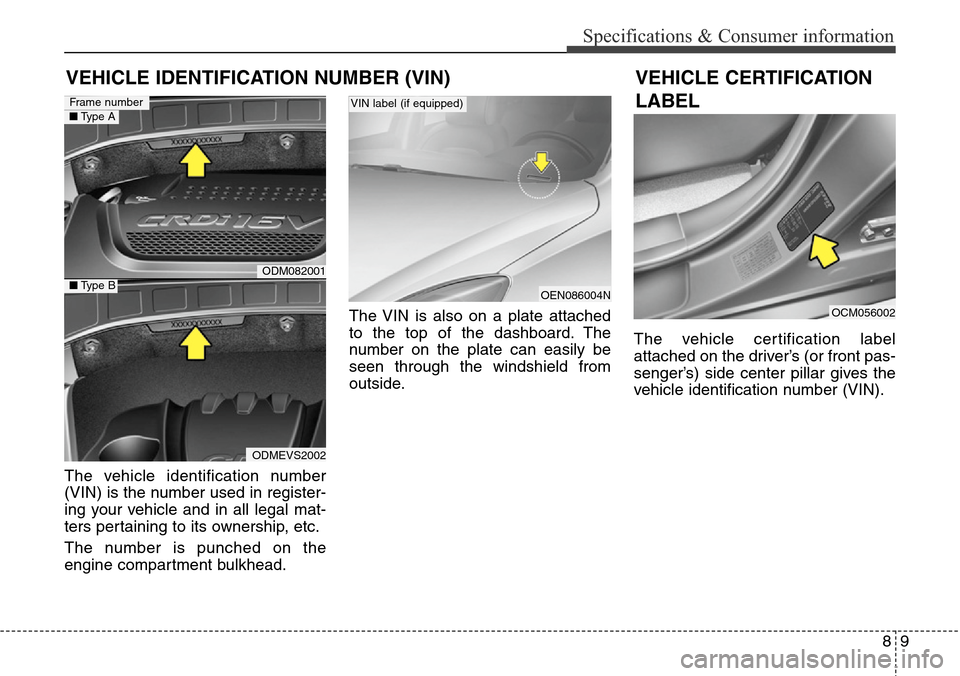
89
Specifications & Consumer information
The vehicle identification number
(VIN) is the number used in register-
ing your vehicle and in all legal mat-
ters pertaining to its ownership, etc.
The number is punched on the
engine compartment bulkhead.The VIN is also on a plate attached
to the top of the dashboard. The
number on the plate can easily be
seen through the windshield from
outside.The vehicle certification label
attached on the driverŌĆÖs (or front pas-
sengerŌĆÖs) side center pillar gives the
vehicle identification number (VIN).
VEHICLE IDENTIFICATION NUMBER (VIN) VEHICLE CERTIFICATION
LABEL
OEN086004N
VIN label (if equipped)
OCM056002
ODM082001
ODMEVS2002
Frame number
Ō¢ĀType B
Ō¢ĀType A
Page 687 of 718
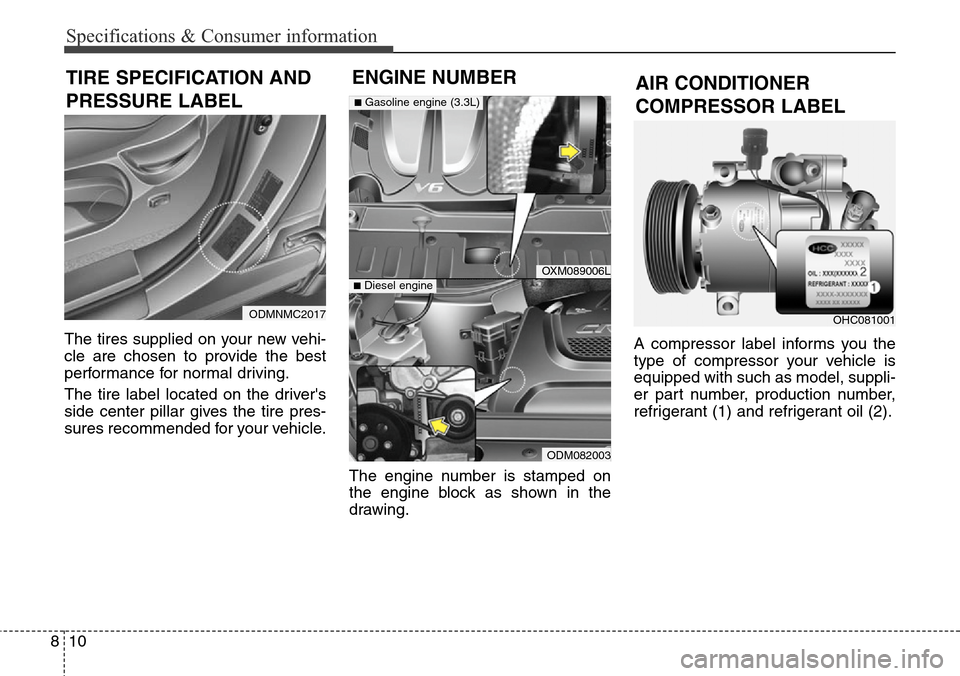
Specifications & Consumer information
10 8
The tires supplied on your new vehi-
cle are chosen to provide the best
performance for normal driving.
The tire label located on the driver's
side center pillar gives the tire pres-
sures recommended for your vehicle.
The engine number is stamped on
the engine block as shown in the
drawing.A compressor label informs you the
type of compressor your vehicle is
equipped with such as model, suppli-
er part number, production number,
refrigerant (1) and refrigerant oil (2).
TIRE SPECIFICATION AND
PRESSURE LABELENGINE NUMBER
ODMNMC2017
OXM089006L
ODM082003
Ō¢ĀGasoline engine (3.3L)
Ō¢ĀDiesel engine
OHC081001
AIR CONDITIONER
COMPRESSOR LABEL
Page 688 of 718
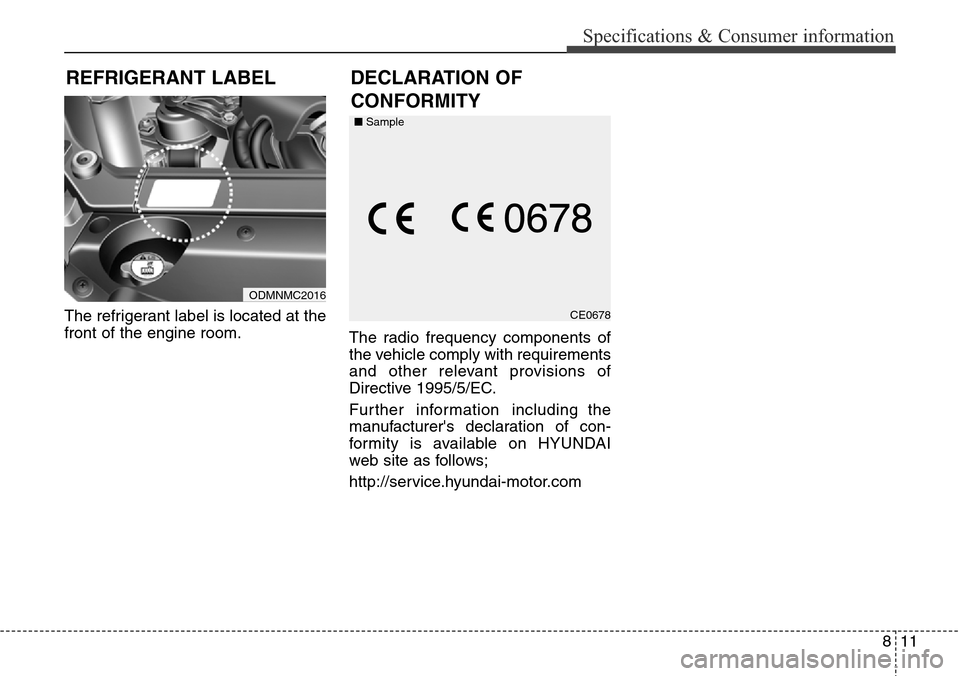
811
Specifications & Consumer information
The refrigerant label is located at the
front of the engine room.
The radio frequency components of
the vehicle comply with requirements
and other relevant provisions of
Directive 1995/5/EC.
Further information including the
manufacturer's declaration of con-
formity is available on HYUNDAI
web site as follows;
http://service.hyundai-motor.com
REFRIGERANT LABEL
ODMNMC2016
DECLARATION OF
CONFORMITY
CE0678 Ō¢ĀSample
Page 689 of 718
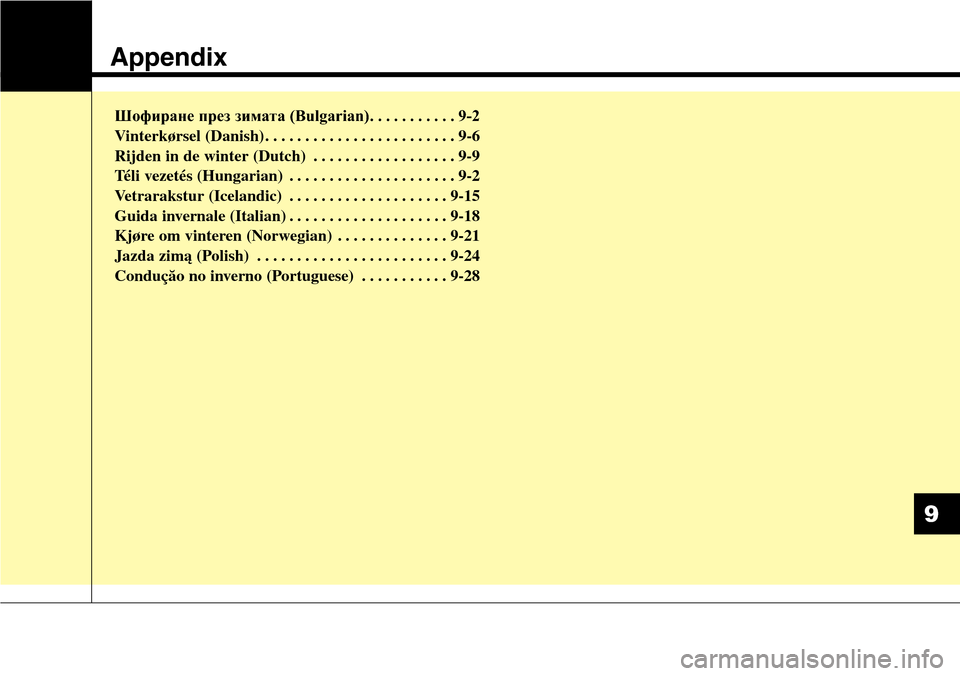
Appendix
ą©ąŠčäąĖčĆą░ąĮąĄ ą┐čĆąĄąĘ ąĘąĖą╝ą░čéą░ (Bulgarian). . . . . . . . . . . 9-2
Vinterk├Ėrsel (Danish) . . . . . . . . . . . . . . . . . . . . . . . . 9-6
Rijden in de winter (Dutch) . . . . . . . . . . . . . . . . . . 9-9
T├®li vezet├®s (Hungarian) . . . . . . . . . . . . . . . . . . . . . 9-2
Vetrarakstur (Icelandic) . . . . . . . . . . . . . . . . . . . . 9-15
Guida invernale (Italian) . . . . . . . . . . . . . . . . . . . . 9-18
Kj├Ėre om vinteren (Norwegian) . . . . . . . . . . . . . . 9-21
Jazdazim─ģ (Polish). . . . . . . . . . . . . . . . . . . . . . . . 9-24
Condu├¦─āo no inverno (Portuguese) . . . . . . . . . . . 9-28
9
Page 690 of 718
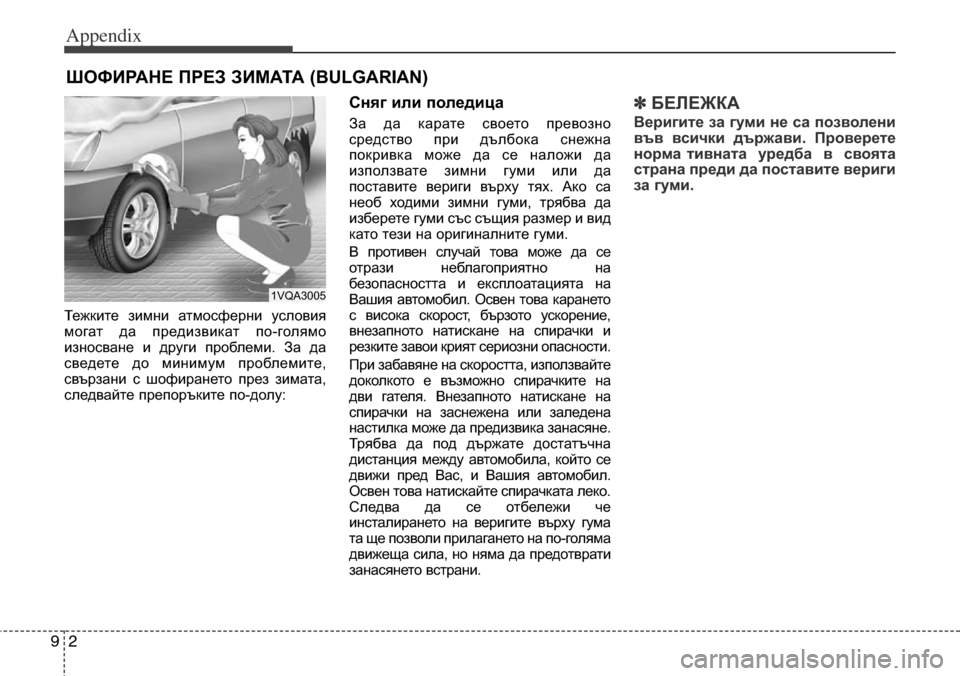
Appendix
2 9
ąóąĄąČą║ąĖč鹥 ąĘąĖą╝ąĮąĖ ą░čéą╝ąŠčüč乥čĆąĮąĖ čāčüą╗ąŠą▓ąĖčÅ
ą╝ąŠą│ą░čé ą┤ą░ ą┐čĆąĄą┤ąĖąĘą▓ąĖą║ą░čé ą┐ąŠ-ą│ąŠą╗čÅą╝ąŠ
ąĖąĘąĮąŠčüą▓ą░ąĮąĄ ąĖ ą┤čĆčāą│ąĖ ą┐čĆąŠą▒ą╗ąĄą╝ąĖ. ąŚą░ ą┤ą░
čüą▓ąĄą┤ąĄč鹥 ą┤ąŠ ą╝ąĖąĮąĖą╝čāą╝ ą┐čĆąŠą▒ą╗ąĄą╝ąĖč鹥,
čüą▓čŖčƹʹ░ąĮąĖ čü čłąŠčäąĖčĆą░ąĮąĄč鹊 ą┐čĆąĄąĘ ąĘąĖą╝ą░čéą░,
čüą╗ąĄą┤ą▓ą░ą╣č鹥 ą┐čĆąĄą┐ąŠčĆčŖą║ąĖč鹥 ą┐ąŠ-ą┤ąŠą╗čā:
ąĪąĮčÅą│ ąĖą╗ąĖ ą┐ąŠą╗ąĄą┤ąĖčåą░
ąŚą░ ą┤ą░ ą║ą░čĆą░č鹥 čüą▓ąŠąĄč鹊 ą┐čĆąĄą▓ąŠąĘąĮąŠ
čüčĆąĄą┤čüčéą▓ąŠ ą┐čĆąĖ ą┤čŖą╗ą▒ąŠą║ą░ čüąĮąĄąČąĮą░
ą┐ąŠą║čĆąĖą▓ą║ą░ ą╝ąŠąČąĄ ą┤ą░ čüąĄ ąĮą░ą╗ąŠąČąĖ ą┤ą░
ąĖąĘą┐ąŠą╗ąĘą▓ą░č鹥 ąĘąĖą╝ąĮąĖ ą│čāą╝ąĖ ąĖą╗ąĖ ą┤ą░
ą┐ąŠčüčéą░ą▓ąĖč鹥 ą▓ąĄčĆąĖą│ąĖ ą▓čŖčĆčģčā čéčÅčģ. ąÉą║ąŠ čüą░
ąĮąĄąŠą▒ čģąŠą┤ąĖą╝ąĖ ąĘąĖą╝ąĮąĖ ą│čāą╝ąĖ, čéčĆčÅą▒ą▓ą░ ą┤ą░
ąĖąĘą▒ąĄčĆąĄč鹥 ą│čāą╝ąĖ čüčŖčü čüčŖčēąĖčÅ čĆą░ąĘą╝ąĄčĆ ąĖ ą▓ąĖą┤
ą║ą░č鹊 č鹥ąĘąĖ ąĮą░ ąŠčĆąĖą│ąĖąĮą░ą╗ąĮąĖč鹥 ą│čāą╝ąĖ.
ąÆ ą┐čĆąŠčéąĖą▓ąĄąĮ čüą╗čāčćą░ą╣ č鹊ą▓ą░ ą╝ąŠąČąĄ ą┤ą░ čüąĄ
ąŠčéčĆą░ąĘąĖ ąĮąĄą▒ą╗ą░ą│ąŠą┐čĆąĖčÅčéąĮąŠ ąĮą░
ą▒ąĄąĘąŠą┐ą░čüąĮąŠčüčéčéą░ ąĖ ąĄą║čüą┐ą╗ąŠą░čéą░čåąĖčÅčéą░ ąĮą░
ąÆą░čłąĖčÅ ą░ą▓č鹊ą╝ąŠą▒ąĖą╗. ą×čüą▓ąĄąĮ č鹊ą▓ą░ ą║ą░čĆą░ąĮąĄč鹊
čü ą▓ąĖčüąŠą║ą░ čüą║ąŠčĆąŠčüčé, ą▒čŖčƹʹŠč鹊 čāčüą║ąŠčĆąĄąĮąĖąĄ,
ą▓ąĮąĄąĘą░ą┐ąĮąŠč鹊 ąĮą░čéąĖčüą║ą░ąĮąĄ ąĮą░ čüą┐ąĖčĆą░čćą║ąĖ ąĖ
čĆąĄąĘą║ąĖč鹥 ąĘą░ą▓ąŠąĖ ą║čĆąĖčÅčé čüąĄčĆąĖąŠąĘąĮąĖ ąŠą┐ą░čüąĮąŠčüčéąĖ.
ą¤čĆąĖ ąĘą░ą▒ą░ą▓čÅąĮąĄ ąĮą░ čüą║ąŠčĆąŠčüčéčéą░, ąĖąĘą┐ąŠą╗ąĘą▓ą░ą╣č鹥
ą┤ąŠą║ąŠą╗ą║ąŠč鹊 ąĄ ą▓čŖąĘą╝ąŠąČąĮąŠ čüą┐ąĖčĆą░čćą║ąĖč鹥 ąĮą░
ą┤ą▓ąĖ ą│ą░č鹥ą╗čÅ. ąÆąĮąĄąĘą░ą┐ąĮąŠč鹊 ąĮą░čéąĖčüą║ą░ąĮąĄ ąĮą░
čüą┐ąĖčĆą░čćą║ąĖ ąĮą░ ąĘą░čüąĮąĄąČąĄąĮą░ ąĖą╗ąĖ ąĘą░ą╗ąĄą┤ąĄąĮą░
ąĮą░čüčéąĖą╗ą║ą░ ą╝ąŠąČąĄ ą┤ą░ ą┐čĆąĄą┤ąĖąĘą▓ąĖą║ą░ ąĘą░ąĮą░čüčÅąĮąĄ.
ąóčĆčÅą▒ą▓ą░ ą┤ą░ ą┐ąŠą┤ ą┤čŖčƹȹ░č鹥 ą┤ąŠčüčéą░čéčŖčćąĮą░
ą┤ąĖčüčéą░ąĮčåąĖčÅ ą╝ąĄąČą┤čā ą░ą▓č鹊ą╝ąŠą▒ąĖą╗ą░, ą║ąŠą╣č鹊 čüąĄ
ą┤ą▓ąĖąČąĖ ą┐čĆąĄą┤ ąÆą░čü, ąĖ ąÆą░čłąĖčÅ ą░ą▓č鹊ą╝ąŠą▒ąĖą╗.
ą×čüą▓ąĄąĮ č鹊ą▓ą░ ąĮą░čéąĖčüą║ą░ą╣č鹥 čüą┐ąĖčĆą░čćą║ą░čéą░ ą╗ąĄą║ąŠ.
ąĪą╗ąĄą┤ą▓ą░ ą┤ą░ čüąĄ ąŠčéą▒ąĄą╗ąĄąČąĖ č湥
ąĖąĮčüčéą░ą╗ąĖčĆą░ąĮąĄč鹊 ąĮą░ ą▓ąĄčĆąĖą│ąĖč鹥 ą▓čŖčĆčģčā ą│čāą╝ą░
čéą░ čēąĄ ą┐ąŠąĘą▓ąŠą╗ąĖ ą┐čĆąĖą╗ą░ą│ą░ąĮąĄč鹊 ąĮą░ ą┐ąŠ-ą│ąŠą╗čÅą╝ą░
ą┤ą▓ąĖąČąĄčēą░ čüąĖą╗ą░, ąĮąŠ ąĮčÅą╝ą░ ą┤ą░ ą┐čĆąĄą┤ąŠčéą▓čĆą░čéąĖ
ąĘą░ąĮą░čüčÅąĮąĄč鹊 ą▓čüčéčĆą░ąĮąĖ.
Ō£ĮąæąĢąøąĢą¢ąÜąÉ
ąÆąĄčĆąĖą│ąĖč鹥 ąĘą░ ą│čāą╝ąĖ ąĮąĄ čüą░ ą┐ąŠąĘą▓ąŠą╗ąĄąĮąĖ
ą▓čŖą▓ ą▓čüąĖčćą║ąĖ ą┤čŖčƹȹ░ą▓ąĖ. ą¤čĆąŠą▓ąĄčĆąĄč鹥
ąĮąŠčĆą╝ą░ čéąĖą▓ąĮą░čéą░ čāčĆąĄą┤ą▒ą░ ą▓ čüą▓ąŠčÅčéą░
čüčéčĆą░ąĮą░ ą┐čĆąĄą┤ąĖ ą┤ą░ ą┐ąŠčüčéą░ą▓ąĖč鹥 ą▓ąĄčĆąĖą│ąĖ
ąĘą░ ą│čāą╝ąĖ.
ą©ą×ążąśąĀąÉąØąĢ ą¤ąĀąĢąŚ ąŚąśą£ąÉąóąÉ (BULGARIAN)
1VQA3005